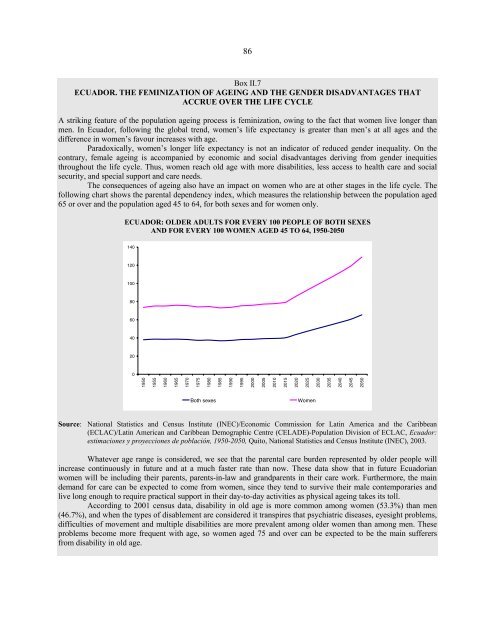Women in Latin America and the Caribbean - Cepal
Women in Latin America and the Caribbean - Cepal
Women in Latin America and the Caribbean - Cepal
Create successful ePaper yourself
Turn your PDF publications into a flip-book with our unique Google optimized e-Paper software.
86<br />
Box II.7<br />
ECUADOR. THE FEMINIZATION OF AGEING AND THE GENDER DISADVANTAGES THAT<br />
ACCRUE OVER THE LIFE CYCLE<br />
A strik<strong>in</strong>g feature of <strong>the</strong> population age<strong>in</strong>g process is fem<strong>in</strong>ization, ow<strong>in</strong>g to <strong>the</strong> fact that women live longer than<br />
men. In Ecuador, follow<strong>in</strong>g <strong>the</strong> global trend, women’s life expectancy is greater than men’s at all ages <strong>and</strong> <strong>the</strong><br />
difference <strong>in</strong> women’s favour <strong>in</strong>creases with age.<br />
Paradoxically, women’s longer life expectancy is not an <strong>in</strong>dicator of reduced gender <strong>in</strong>equality. On <strong>the</strong><br />
contrary, female age<strong>in</strong>g is accompanied by economic <strong>and</strong> social disadvantages deriv<strong>in</strong>g from gender <strong>in</strong>equities<br />
throughout <strong>the</strong> life cycle. Thus, women reach old age with more disabilities, less access to health care <strong>and</strong> social<br />
security, <strong>and</strong> special support <strong>and</strong> care needs.<br />
The consequences of age<strong>in</strong>g also have an impact on women who are at o<strong>the</strong>r stages <strong>in</strong> <strong>the</strong> life cycle. The<br />
follow<strong>in</strong>g chart shows <strong>the</strong> parental dependency <strong>in</strong>dex, which measures <strong>the</strong> relationship between <strong>the</strong> population aged<br />
65 or over <strong>and</strong> <strong>the</strong> population aged 45 to 64, for both sexes <strong>and</strong> for women only.<br />
ECUADOR: OLDER ADULTS FOR EVERY 100 PEOPLE OF BOTH SEXES<br />
AND FOR EVERY 100 WOMEN AGED 45 TO 64, 1950-2050<br />
140<br />
120<br />
100<br />
80<br />
60<br />
40<br />
20<br />
0<br />
1950<br />
1955<br />
1960<br />
1965<br />
1970<br />
1975<br />
1980<br />
1985<br />
1990<br />
1995<br />
2000<br />
2005<br />
2010<br />
2015<br />
2020<br />
2025<br />
2030<br />
2035<br />
2040<br />
2045<br />
2050<br />
Both sexes<br />
<strong>Women</strong><br />
Source: National Statistics <strong>and</strong> Census Institute (INEC)/Economic Commission for Lat<strong>in</strong> <strong>America</strong> <strong>and</strong> <strong>the</strong> <strong>Caribbean</strong><br />
(ECLAC)/Lat<strong>in</strong> <strong>America</strong>n <strong>and</strong> <strong>Caribbean</strong> Demographic Centre (CELADE)-Population Division of ECLAC, Ecuador:<br />
estimaciones y proyecciones de población, 1950-2050, Quito, National Statistics <strong>and</strong> Census Institute (INEC), 2003.<br />
Whatever age range is considered, we see that <strong>the</strong> parental care burden represented by older people will<br />
<strong>in</strong>crease cont<strong>in</strong>uously <strong>in</strong> future <strong>and</strong> at a much faster rate than now. These data show that <strong>in</strong> future Ecuadorian<br />
women will be <strong>in</strong>clud<strong>in</strong>g <strong>the</strong>ir parents, parents-<strong>in</strong>-law <strong>and</strong> gr<strong>and</strong>parents <strong>in</strong> <strong>the</strong>ir care work. Fur<strong>the</strong>rmore, <strong>the</strong> ma<strong>in</strong><br />
dem<strong>and</strong> for care can be expected to come from women, s<strong>in</strong>ce <strong>the</strong>y tend to survive <strong>the</strong>ir male contemporaries <strong>and</strong><br />
live long enough to require practical support <strong>in</strong> <strong>the</strong>ir day-to-day activities as physical age<strong>in</strong>g takes its toll.<br />
Accord<strong>in</strong>g to 2001 census data, disability <strong>in</strong> old age is more common among women (53.3%) than men<br />
(46.7%), <strong>and</strong> when <strong>the</strong> types of disablement are considered it transpires that psychiatric diseases, eyesight problems,<br />
difficulties of movement <strong>and</strong> multiple disabilities are more prevalent among older women than among men. These<br />
problems become more frequent with age, so women aged 75 <strong>and</strong> over can be expected to be <strong>the</strong> ma<strong>in</strong> sufferers<br />
from disability <strong>in</strong> old age.











